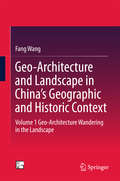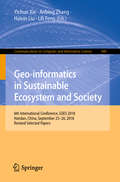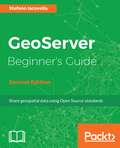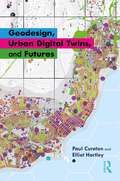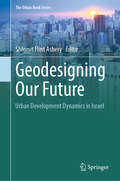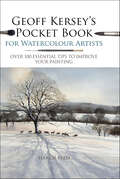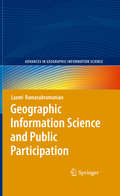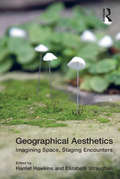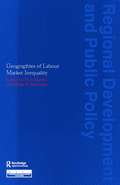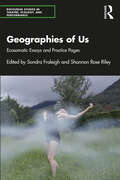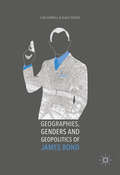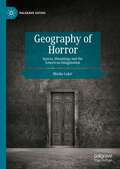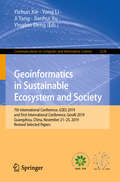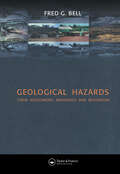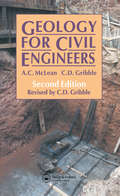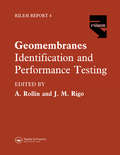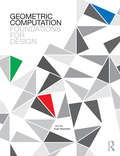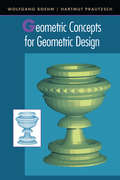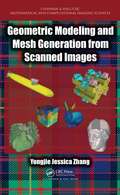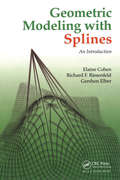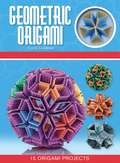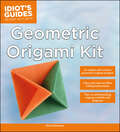- Table View
- List View
Geo-Architecture and Landscape in China's Geographic and Historic Context
by Fang WangThis book explores the concept of geo-architecture by analyzing the ways architectures are related to the local geography, including mingling or contrasting with surrounding landscape, adapting to mountainous or aquatic terrain, and selection of construction materials. Architectures build with such skillfully contrived strategies and techniques have become live exhibit of folk customs and served to record in profound detail the long history of mankind's recognition of nature. The combined effect is such that the architecture grows out of the surrounding natural and human environment. This book is the third of a 4-volume book series. The series develops the innovative concept of "geo-architecture" by exploring the myriad influences of natural, human and historical factors upon architecture. These influences are considered in three categories, namely, interaction between architecture and nature, interaction between architecture and its human users and change in architecture over time--each category serves as a lens. Augmenting these lenses is the Time-Person-Place concept applied different geographic. The analysis ultimately focuses on two aspects: geographic influence on architecture and architectural response to geography. The over 1000 pictures of case architectures enriches the study with stunning and unique visual angles. "This unprecedented work will be a unique and valuable contribution to the literature. Integrating as it does the disciplines of architecture, landscape architecture, and geography, Wang Fang's voice is original, compelling, and will be much appreciated by English-speaking readers (and inside China, too, I can only imagine. )" Stephen M Ervin Assistant Dean Graduate School of Design, Harvard University July 2nd, 2013 "One reason for why there would be interest is because her research would fill some significant gaps in the literature. What is novel about Dr. Wang's series is that she further extends this intellectual project of looking at Chinese architecture through Chinese eyes, by taking it one provocative step further. " Annette M. Kim Associate Professor Department of Urban Studies and Planning, M. I. T. July 1st, 2013
Geo-informatics in Sustainable Ecosystem and Society: 6th International Conference, GSES 2018, Handan, China, September 25–26, 2018, Revised Selected Papers (Communications in Computer and Information Science #980)
by Yichun Xie Anbing Zhang Haixin Liu Lili FengThis book constitutes the refereed proceedings of the 6th International Conference on Geo-informatics in Sustainable Ecosystem and Society, GSES 2018, held in Handan, China, in September 2018. The 46 papers presented in this volume were carefully reviewed and selected from 153 submissions and focus on spatial data acquisition, processing and management, modeling and analysis, and recent applications in the context of building healthier ecology and resource management using advanced remote sensing technology and spatial data modeling and analysis.
GeoServer Beginner's Guide - Second Edition
by Stefano IacovellaThis step-by-step guide will teach you how to use GeoServer to build custom and interactive maps using your data. About This Book • Exploit the power of GeoServer to provide agile, flexible, and low -cost community projects • Share real-time maps quickly • Boost your map server's performance using the power and flexibility of GeoServer Who This Book Is For If you are a web developer with knowledge of server side scripting, have experience in installing applications on the server, and want to go beyond Google Maps by offering dynamically built maps on your site with your latest geospatial data stored in MySQL, PostGIS, MySQL, or Oracle, this is the book for you. What You Will Learn • Install GeoServer quickly • Access dynamic real-time geospatial data that you can easily integrate into your own web-based application • Create custom styles for lines, points, and polygons for great-looking maps • Command GeoServer remotely using REST • Tune your GeoServer instance for performance • Move GeoServer into production • Learn advanced topics to extend GeoServer's capabilities In Detail GeoServer is an opensource server written in Java that allows users to share, process, and edit geospatial data. This book will guide you through the new features and improvements of GeoServer and will help you get started with it. GeoServer Beginner's Guide gives you the impetus to build custom maps using your data without the need for costly commercial software licenses and restrictions. Even if you do not have prior GIS knowledge, you will be able to make interactive maps after reading this book. You will install GeoServer, access your data from a database, and apply style points, lines, polygons, and labels to impress site visitors with real-time maps. Then you follow a step-by-step guide that installs GeoServer in minutes. You will explore the web-based administrative interface to connect to backend data stores such as PostGIS, and Oracle. Going ahead, you can display your data on web-based interactive maps, use style lines, points, polygons, and embed images to visualize this data for your web visitors. You will walk away from this book with a working application ready for production. After reading GeoServer Beginner's Guide, you will be able to build beautiful custom maps on your website using your geospatial data. Style and approach Step-by-step instructions are included and the needs of a beginner are totally satisfied by the book. The book consists of plenty of examples with accompanying screenshots and code for an easy learning curve.
Geodesign, Urban Digital Twins, and Futures
by Paul Cureton Elliot HartleyGeodesign, Urban Digital Twins, and Futures explores systems, processes, and novel technologies for planning, mapping, and designing our built environment. In a period of advancing urban infrastructure, technological autonomy in cities, and high-performance geographic systems, new capabilities, novel techniques, and streamlined procedures have emerged concurrently with climatic challenges, pandemics, and increasing global urbanisation. Chapters cover a range of topics such as urban digital twins, GeoBIM, geodesign and collaborative tools, immersive environments, gamification, and future methods. This book features over 100 international projects and workflows, five detailed case studies, and a companion website. In addition, this book examines geodesign as an agent for collaboration alongside futuring methods for imagining and understanding our future world.The companion website for this book can be accessed at http://geodesigndigitaltwins.com.
Geodesigning Our Future: Urban Development Dynamics in Israel (The Urban Book Series)
by Shlomit Flint AsheryThis book examines how map-based collaboration software can facilitate negotiations in areas undergoing contentious pressures for significant change. Based on case studies from Israel, it aims to introduce a useful model of planning implementation as an outcome of complex interaction to reduce the gap between planning and urban reality. It puts an analytical realist foundation for a productive discussion of the role of future planning and bares meaningful scientific contributions to the general frame of the negotiating process and implementation, which still needs further research and elaboration.Geodesign, a cutting-edge planning approach that is rooted in the history of planning practice, has become one of the most popular approaches for sustainable planning and design activities after 2000s. Planners tend to think of design at a site scale, but geodesign covers a variety of scales, bridging the gap between the regional and the local contexts.This is important because to be practically effective and politically prudent, "smart growth" plans need to make sense across a spectrum of scales and disciplines. This ranges from design, urban design, community planning, town and city planning, and regional planning, up to planning for mega-regions.
Geoff Kersey’s Pocket Book for Watercolour Artists: Over 100 Essential Tips to Improve Your Painting
by Geoff KerseyGeoff Kersey shares his expertise in this book packed full of tips for watercolour painters. Learn all you need to know, from what to buy, composing a painting and mastering techniques such as wet into wet and dry brush work, to how to paint skies, water, trees, buildings and more. The tips are clearly explained and illustrated through artwork and step-by-step photographs.This title was previously published as Geoff's Top Tips for Watercolour Artists. In this new, easy-to-use flexibinding format with an updated design, the books in the Watercolour Artists’ Pocket Books series bring you the best tips from some of Search Press's leading authors.
Geographic Information Science and Public Participation
by Laxmi RamasubramanianComputer-mediated participation is at the crossroads. In the early heady days of the digital revolution, access to "high" technologies such as GIS promised the empowerment of marginalized communities by providing data and information that was previously hidden away from public view. To a great extent, this goal has been achieved at least in the U.S. and Western Europe - data about a range of government initiatives and raw data about different aspects of spatial planning such as land use, community facilities, property ownership are available a mouse-click away. Now, that we, the public, have access to information, are we able to make better plans for the future of our cities and regions? Are we more inclusive in our planning efforts? Are we able to foster collaborative governance structures mediated by digital technologies? In the book, these issues will be discussed using a three-part structure. The first part of the book will be theoretical - it will review the literature in the field, establish a framework to organize the literature and to link three different subject areas (participation and community development, GIS and other related technologies, and planning processes). The second part of the book will be a series of success stories, case studies that review actual situations where participatory planning using GIS has enabled community wellbeing and empowerment. These case studies will vary in scale and focus on different planning issues (planning broadly defined). The final part of the book will step back to review alternative scenarios for the future, exploring where we are headed, as the technologies we are using to plan rapidly change.
Geographical Aesthetics: Imagining Space, Staging Encounters
by Elizabeth StraughanGeographical Aesthetics places the terms 'aesthetics' and 'geography' under critical question together, responding both to the increasing calls from within geography to develop a 'geographical aesthetics', and a resurgence of interdisciplinary interest in conceptual and empirical questions around geoaesthetics, environmental aesthetics, as well as the spatialities of the aesthetic. Despite taking up an identifiable role within the geographical imagination and sensibilities for centuries, and having what is arguably a key place in the making of the modern discipline, aesthetics remains a relatively under-theorized field within geography. Across 15 chapters Geographical Aesthetics brings together timely commentaries by international, interdisciplinary scholars to rework historical relations between geography and aesthetics, and reconsider how it is we might understand aesthetics. In renewing aesthetics as a site of investigation, but also an analytic object through which we can think about worldly encounters, Geographical Aesthetics presents a reworking of our geographical imaginary of the aesthetic.
Geographies of Labour Market Inequality (Regions and Cities)
by Ron Martin Philip S. MorrisonIn recent years, the local dimensions of the labour market have attracted increasing attention from academic analysts and public policy-makers alike. There is growing realization that there is no such thing as the national labour market, instead a mosaic of local and regional markets that differ in nature, performance and regulation. Geographies of Labour Market Inequality is concerned with these multiple geographies of employment, unemployment, work and incomes, and their implications for public policy.
Geographies of Us: Ecosomatic Essays and Practice Pages (Routledge Studies in Theatre, Ecology, and Performance)
by Sondra Fraleigh Shannon Rose RileyGeographies of Us: Ecosomatic Essays and Practice Pages is the first edited collection in the field of ecosomatics.With a combination of essays and practice pages that provide a variety of scholarly, creative, and experience-based approaches for readers, the book brings together both established and emergent scholars and artists from many diverse backgrounds and covers work rooted in a dozen countries. The essays engage an array of crucial methodologies and critical/theoretical perspectives, including practice-based research in the arts, especially in performance and dance studies, critical theory, ecocriticism, Indigenous knowledges, material feminist critique, quantum field theory, and new phenomenologies. Practice pages are shorter chapters that provide readers a chance to engage creatively with the ideas presented across the collection. This book offers a multidisciplinary perspective that brings together work in performance as research, phenomenology, and dance/movement; this is one of its significant contributions to the area of ecosomatics.The book will be of interest to anyone curious about matters of embodiment, ecology, and the environment, especially artists and students of dance, performance, and somatic movement education who want to learn about ecosomatics and environmental activists who want to learn more about integrating creativity, the arts, and movement into their work.
Geographies, Genders and Geopolitics of James Bond
by Klaus Dodds Lisa FunnellThis book discusses the representational geographies of the Bond film franchise and how they inform our reading of 007 as a hero. Offering a new and interdisciplinary lens through which the franchise can be analyzed, Funnell and Dodds explore a range of topics that have been largely, if not entirely, overlooked in Bond film scholarship. These topics include: the shifting and gendering of geopolitical relations; the differing depiction and evaluation of vertical/modern and horizontal/pre-modern spaces; the use of classical elements in defining gender, sexuality, heroic competency, and geopolitical conflict; and the ongoing importance of haptics (i. e. touch), kinesics (i. e. movement), and proxemics (i. e. the use of space) in defining the embodied and emotive world of Bond. This book is comprehensive in nature and scope as it discusses all 24 films in the official Bond canon and theorizes about the future direction of the franchise.
Geography of Horror: Spaces, Hauntings and the American Imagination (Palgrave Gothic)
by Marko LukićThis book provides a comprehensive reading of a space/place-based experience from the birth of the American horror genre (nineteenth century American Romanticism) to its rise and evolution in the twentieth and twenty-first centuries. Exploring a series of narratives, this study focuses on the role of space and place as key elements for successful articulation of horror. The analysis, therefore, employs different theoretical premises and concepts belonging to human geography, which, while being part of the larger discipline of geography, predominantly directs its attention towards the presence and activities of humans. By connecting such theoretical readings with the continuously evolving American horror genre, this book offers a unique insight into the academically unexplored trans-disciplinary spatially based reading of the genre.
Geoinformatics in Sustainable Ecosystem and Society: 7th International Conference, GSES 2019, and First International Conference, GeoAI 2019, Guangzhou, China, November 21–25, 2019, Revised Selected Papers (Communications in Computer and Information Science #1228)
by Yong Li Yichun Xie Ji Yang Jianhui Xu Yingbin DengThis book constitutes the refereed proceedings of the 7th International Conference on Geoinformatics in Sustainable Ecosystem and Society, GSES 2019, and First International Conference on Geospatial Artificial Intelligence for Urban Computing, GeoAI 2019, held in Guangzhou, China, in November 2019.The 29 full papers and 3 short papers presented in this volume were carefully reviewed and selected from 80 submissions. The papers are organized according to the following topical sections: the applications of geospatial data in the sustainable development of social economy; new approaches for earth observation data acquisition and processing; remote sensing monitoring of resources and environment and intelligent analysis; intelligent perceptions and services of spatial information; ecology, environment and social sustainable development.
Geological Hazards: Their Assessment, Avoidance and Mitigation
by Fred G. BellNatural hazards cost the global economy over $50,000 million per year. Two thirds of this is spent on damage repair, the remainder represents the cost of predicting, preventing and mitigating against disasters. Man-made hazards such as groundwater pollution, subsidence and soil erosion add to this figure. Geological Hazards presents a state-of-the-art survey and examines methods of assessing, evaluating and combating hazards, both natural and man-made.
Geology for Civil Engineers
by C. Gribble A. McLeanThis seasoned textbook introduces geology for civil engineering students. It covers minerals and rocks, superficial deposits and the distribution of rocks at or below the surface. It then looks at groundwater and gives guidance on the exploration of a site before looking at the civil engineering implications of rocks and the main geological factors which affect typical engineering projects.
Geomembranes - Identification and Performance Testing
by A. Rollin J-M. RigoGeomembranes are increasingly being used in transportation, environmental and geotechnical applications to control gas and liquid movement. This book provides authoritative guidance on testing of geomembranes. It has been prepared by an international committee of experts under the auspices of RILEM, the International Union of Research and Testing L
Geometric Computation: Foundations For Design Applications
by Joy Ko Kyle SteinfeldGeometric Computation: Foundations for Design describes the mathematical and computational concepts that are central to the practical application of design computation in a manner tailored to the visual designer. Uniquely pairing key topics in code and geometry, this book develops the two key faculties required by designers that seek to integrate computation into their creative practice: an understanding of the structure of code in object-oriented programming, and a proficiency in the fundamental geometric constructs that underlie much of the computational media in visual design.
Geometric Concepts for Geometric Design
by Hartmut Prautzsch Wolfgang BoehmThis book is a comprehensive tool both for self-study and for use as a text in classical geometry. It explains the concepts that form the basis for computer-aided geometric design.
Geometric Modeling and Mesh Generation from Scanned Images (Chapman & Hall/CRC Mathematical and Computational Imaging Sciences Series #6)
by Yongjie Jessica ZhangCutting-Edge Techniques to Better Analyze and Predict Complex Physical Phenomena Geometric Modeling and Mesh Generation from Scanned Images shows how to integrate image processing, geometric modeling, and mesh generation with the finite element method (FEM) to solve problems in computational biology, medicine, materials science, and engineering. Based on the author’s recent research and course at Carnegie Mellon University, the text explains the fundamentals of medical imaging, image processing, computational geometry, mesh generation, visualization, and finite element analysis. It also explores novel and advanced applications in computational biology, medicine, materials science, and other engineering areas. One of the first to cover this emerging interdisciplinary field, the book addresses biomedical/material imaging, image processing, geometric modeling and visualization, FEM, and biomedical and engineering applications. It introduces image-mesh-simulation pipelines, reviews numerical methods used in various modules of the pipelines, and discusses several scanning techniques, including ones to probe polycrystalline materials. The book next presents the fundamentals of geometric modeling and computer graphics, geometric objects and transformations, and curves and surfaces as well as two isocontouring methods: marching cubes and dual contouring. It then describes various triangular/tetrahedral and quadrilateral/hexahedral mesh generation techniques. The book also discusses volumetric T-spline modeling for isogeometric analysis (IGA) and introduces some new developments of FEM in recent years with applications.
Geometric Modeling with Splines: An Introduction
by Elaine Cohen Richard F. Riesenfeld Gershon ElberWritten by researchers who have helped found and shape the field, this book is a definitive introduction to geometric modeling. The authors present all of the necessary techniques for curve and surface representations in computer-aided modeling with a focus on how the techniques are used in design.
Geometric Origami
by Richard L. Alexander Michael G. LafosseThis impressive origami ebook contains everything you need to create beautiful, geometric origami sculptures.Art and math intertwine in exciting and complex new ways in Geometric Origami Kit. World renowned origami artists Michael G. LaFosse and Richard L. Alexander bring you this paper craft ebook where folding a piece of paper creates a new and wondrous origami object. In Geometric Origami, the initial folds are easily created, but once the basic building blocks are ready, the intricate combining of these pieces form new geometric origami sculptures that interlock into interchangeable origami puzzles. Ideal for demonstrating the sophistication and wonder of geometry, they can also be great conversation starting decorations for the home or office. This ebook and downloadable material provide the beginning folder with a series of fun, modular origami projects that represent a wide variety of subjects and techniques.This origami ebook includes:Full-color 64-page book Step-by-step instructions and easy-to-follow diagrams Downloadable materialAt a glance, Geometric Origami may seem too difficult to attempt, but once the methods are broken down and explained they are quite simple and can be completed by children and or beginning origami students. The intricate, multi-paper origami sculptures will put your paper folding skills on a whole new level and are excellent for use in the classroom, for art, math or geometry investigations.Origami projects include:Compass Star AsterLightning Bolt OctahedronButterfly BallPicture CubeModular CraneSonobe Module and CubeMagic Rose Cube
Geometric Origami
by Michael Lafosse Richard AlexanderThis compact origami kit contains everything you need to create beautiful, geometric origami sculptures. Art and math intertwine in exciting and complex new ways in Geometric Origami Kit. World renowned origami artists Michael G. LaFosse and Richard L. Alexander bring you this paper craft kit where folding a piece of paper creates a new and wondrous origami object. In Geometric Origami, the initial folds are easily created, but once the basic building blocks are ready, the intricate combining of these pieces form new geometric origami sculptures that interlock into interchangeable origami puzzles. Ideal for demonstrating the sophistication and wonder of geometry, they can also be great conversation starting decorations for the home or office. This kit and DVD provide the beginning folder with a series of fun, modular origami projects that represent a wide variety of subjects and techniques. This origami kit includes: Full-color 32-page book Step-by-step instructions and easy-to-follow diagrams DVD with video tutorial 120 sheets of durable authentic origami paper A variety of different colors At a glance, Geometric Origami may seem too difficult to attempt, but once the methods are broken down and explained they are quite simple and can be completed by children and or beginning origami students. The intricate, multi-paper origami sculptures will put your paper folding skills on a whole new level and are excellent for use in the classroom, for art, math or geometry investigations. Origami projects include: Harlequin Cube Chevron Pinwheel Dazzle Star Hedgehog Dado Stellated Octahedron
Geometric Origami
by Michael Lafosse Richard AlexanderThis impressive origami ebook contains everything you need to create beautiful, geometric origami sculptures. Art and math intertwine in exciting and complex new ways in Geometric Origami Kit. World renowned origami artists Michael G. LaFosse and Richard L. Alexander bring you this paper craft ebook where folding a piece of paper creates a new and wondrous origami object. In Geometric Origami, the initial folds are easily created, but once the basic building blocks are ready, the intricate combining of these pieces form new geometric origami sculptures that interlock into interchangeable origami puzzles. Ideal for demonstrating the sophistication and wonder of geometry, they can also be great conversation starting decorations for the home or office. This ebook and downloadable material provide the beginning folder with a series of fun, modular origami projects that represent a wide variety of subjects and techniques. This origami ebook includes: Full-color 64-page book Step-by-step instructions and easy-to-follow diagrams Downloadable material At a glance, Geometric Origami may seem too difficult to attempt, but once the methods are broken down and explained they are quite simple and can be completed by children and or beginning origami students. The intricate, multi-paper origami sculptures will put your paper folding skills on a whole new level and are excellent for use in the classroom, for art, math or geometry investigations. Origami projects include: Compass Star Aster Lightning Bolt Octahedron Butterfly Ball Picture Cube Modular Crane Sonobe Module and Cube Magic Rose Cube
Geometric Origami (Origami Books)
by Faye GoldmanToo hip to be square, Geometric Origami takes the art of paper folding to stunning new heights.A sophisticated new origami kit for advanced paper-folding enthusiasts, Geometric Origami takes paper art to spectacular new levels. Fifteen intricate paper projects use specially designed strips that come with the book and include a tetrahedron, hexahedron, octahedron, dodecahedron, icosahedron, truncated tetrahedron, cuboctahedron, icosidodecahedron, rhombic triacontahedron, snub dodecahedron, zonohedron, and buckyballs. And don't worry - there are even a few pronounceable shapes like the egg and a geometric bracelet, plus more surprises. This beautifully designed kit gives a new perspective on geometry and the world of origami and is great fun for the entire family - or the perfect gift for a math professor.
Geometric Origami Kit (Idiot's Guides)
by Nick RobinsonIncludes 80 sheets of Origami paper! Idiot's Guides: Geometric Origami Kit makes learning this art easy and fun. For the young or young-at-heart, this full-color book offers 20 beautiful geometric Origami projects and 80 sheets of Origami paper to construct them. In addition, lay-flat spiral binding makes the detailed steps even easier to follow.
